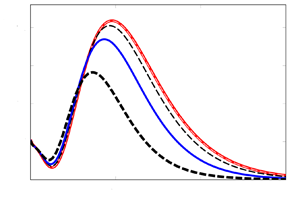No CrossRef data available.
Article contents
Entrainment and growth of vortical disturbances in the channel-entrance region
Published online by Cambridge University Press: 24 September 2021
Abstract

The entrainment of free-stream unsteady three-dimensional vortical disturbances in the entry region of a channel is studied via matched asymptotic expansions and by numerical means. The interest is in flows at Reynolds numbers where experimental studies have documented the occurrence of intense transient growth, despite the flow being stable according to classical stability analysis. The analytical description of the vortical perturbations at the channel mouth reveals how the oncoming disturbances penetrate into the wall-attached shear layers and amplify downstream. The effects of the channel confinement, the streamwise pressure gradient and the viscous/inviscid interplay between the oncoming disturbances and the boundary-layer perturbations are discussed. The composite perturbation velocity profiles are employed as initial conditions for the unsteady boundary-region perturbation equations. At a short distance from the channel mouth, the disturbance flow is mostly confined within the shear layers and assumes the form of streamwise-elongated streaks, while farther downstream the viscous disturbances permeate the whole channel although the base flow is still mostly inviscid in the core. Symmetrical disturbances exhibit a more significant growth than anti-symmetrical disturbances, the latter maintaining a nearly constant amplitude for several channel heights downstream before growing transiently, a unique feature not reported in open boundary layers. The disturbances are more intense as the frequency decreases or the bulk Reynolds number increases. We compute the spanwise wavelengths that cause the most intense downstream growth and the threshold wall-normal wavelengths below which the perturbations are damped through viscous dissipation.
- Type
- JFM Papers
- Information
- Copyright
- © The Author(s), 2021. Published by Cambridge University Press





